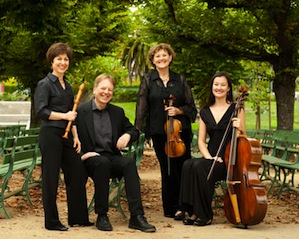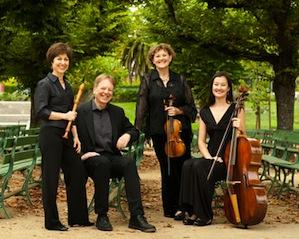
Saturday’s concert by early chamber ensemble Musica Pacifica probably took on a different flavor in a repeat performance I heard at Palo Alto’s First Lutheran church than at its premiere at Ashkenaz, Berkeley’s folk music joint on San Pablo Avenue. The ensemble struck a good programmatic balance between their choices of early English chamber music and their arrangements of early English, Scottish, and Irish folk tunes.
I lacked the intimate knowledge of English country dance melodies of member Judith Linsenberg, who regularly plays this music for dance ensembles on recorder. The band performed four sets of dance and folk tunes in complete arrangements or to charts by the band’s front man, fiddlist Elizabeth Blumenstock. Although they are early-music specialists, their performing practice and arrangement structure was identical to the way most garage bands function, which serves as a reminder that rock music is substantially a type of folk art. Underscoring the point was the addition of percussionist John Loose to the ensemble.
These are excellent and experienced performers, and I neither expected nor found fault with their playing. Consumed by the white lighting of a church without headbanging from the mosh pit and visits to the bar, the concert directed more-intense audience focus on the folk tunes than is typical in performances at places such as Ashkenaz. Musica Pacifica delivered the right amount of polish to retain the musical interest through the litany of four-bar phrases and simplistic harmony. They caught the whimsical spirit of a playful feline in the Scottish tune Old Grey Cat, tore up the calico in the Irish Tear the Calico, and held the audience in the noble ballad Niel Gow’s Lament for his Second Wife.
Familiarity Breeds Fondness
Modern audiences are quite removed from this folk repertory. In the 18th century, these melodies were familiar to both those in the publick house and those in the village. To quote literary critic Frederic Jameson, “the passionate attachments one can form [to pop works] are fully as much a function of our own familiarity as of the work itself ... this is a very different situation from the first bewildered audition of a complicated classical piece ... What we listen to is ourselves, our own previous auditions.” The ensemble brought this point home to me in their performance of music from Purcell’s King Arthur, a work I know very well because I participated in a good staged performance in 2006.
Blumenstock tossed off blazing runs and left-hand pizzicatos flawlessly and with aplomb.
Hearing these melodies again from a minor cover band recalled fond memories of that production, and I perceived them with more respect than hearing them fresh. I could even sing along, if I wished. In classical/art music, overfamiliarity can breed contempt, but in pop and folk music (King Arthur was the pop of its day), it breeds nostalgia and enthusiasm.
The ensemble wisely programmed weightier composed works to counterbalance the program and fix the attention of a dutiful classical audience. These included suites and trio sonatas by Nicola Mattheis, Mathew Locke, and again Purcell. Unlike the foursquare folk tunes, these works abounded in asymmetric phrases, eccentric cross-rhythms, and piquant detail, always demanding audience attention. Especially notable was Tregian’s Ground by Daniel Norcombe, played by Shirley Hunt on viola da gamba supported by Charles Sherman on harpsichord. The work is something of an inverted Greensleeves expanded to its maximal potential.
The boundary between classical art music and pop or folk music does not need to be one of elitism.
The musical highlight was Blumenstock’s virtuosic performance of Robert Bremner’s (1713–1789) fiddle variations on Hit Her on the Bum, arranged by David Johnson (to learn more about the piece, avoid searching the Internet from a work computer). Bremner was a student of Geminiani, now famous for his 1751 publication of the Art of Playing the Violin, so this was no light bundle of musical miscellany. Blumenstock tossed off blazing runs and left-hand pizzicatos flawlessly and with aplomb. Bawdy songs have a long history on the street as in the concert hall. Recalling famous scenes from John Wayne’s McLintock or Cole Porter’s Kiss Me Kate, lady-spanking had a certain acceptable entertainment value until quite recently, and this arguably continues in recent pop acts such as Rhianna.
The boundary between classical art music and pop or folk music does not need to be one of elitism; rather, it could be viewed as one of familiarity and audience attention. Programs like the one I heard Saturday reveal how the genres are very similar — and very different.

